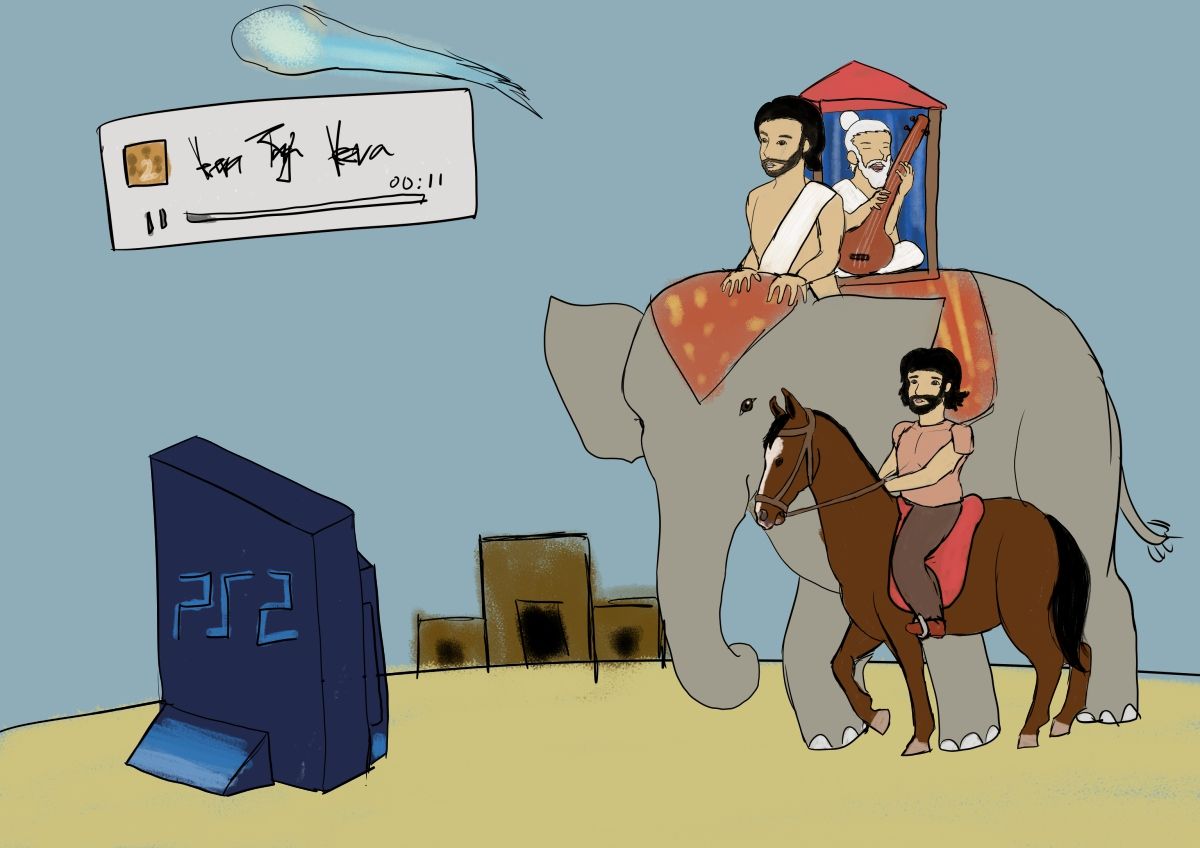Shiva, Veera, or Both
Oral traditions, the new hit song, and the fine line between inspiration and exploitation.

Oral traditions, a new hit song, and the fine line between inspiration and exploitation.
The film Ponniyin Selvan II or PS-II is out now, and it seems like half the population is completely psyched at this fact and the other half doesn’t know what that means and wonders when I got into gaming.
Ponniyin Selvan. The epic Tamil novel, penned by genius writer Kalki in the mid-20th century, is hard to describe. A whirlwind historical adventure set thousands of years ago in the Chola Kingdom, it has everything you might ask for and more. A lively kingdom; handsome princes; high adventure; scheming and devious villains with tragic backstories. Add to this plenty of scandals, plot twists right left and centre, and women who talk back against the patriarchy—even stepping through a very radical door for that time by suggesting the concept of women marrying each other instead of a man (although, unfortunately but not surprisingly, this idea was not developed further).
Given all this and its frequent historical references to Tamil culture and heritage, the novel has gained an almost cult-like following over the decades. It has also become infamous for not being adaptable to a movie format, with multiple failed attempts rivalling those of Dune.
Therefore, when renowned director Mani Ratnam took up the challenge last year — and pulled it off spectacularly — everyone from schoolkids to their grandparents flooded the theatres.
Given the size of the novel, the adaptation was divided in two parts. The first was met with pretty much resounding approval. Now the second film has been released, and it’s not just the film itself that’s the talk of the town but also the soundtrack by iconic composer A.R. Rahman.
However, for Dhrupad musicians, especially those in the Dagarvani tradition, a particular song from the new release hits different. Veera Raja Veera is being praised as one of A.R. Rahman’s latest hits.
But that song is an almost direct cut and paste of the Dhrupad composition Shiva Shiva Shiva.
Set in raag Adana, the original composition, as the name suggests, is in praise of Lord Shiva. For those who don't know, 'raag' very loosely translates to melodic scale or framework; Adana is a Carnatic raag which, like Kirwani and Charukeshi, was adopted by the Dhrupad tradition, in an example of cultural exchange in oral traditions.
A.R. Rahman’s Veera Raja Veera follows the melody of Shiva Shiva Shiva almost exactly, save for different lyrics, extra harmonies and instrumental scores, and a different melody interspersed between stanzas.
Upon hearing the song, Dhrupad musician Ustad Wasifuddin Dagar immediately flagged it as a copy of Shiva Shiva Shiva, which was originally composed and sung by his father Zahiruddin Dagar and uncle Faiyazuddin Dagar. Members of the Dagar family, as well as their students, have spoken out about this instance of direct copying, but whether anything will come out of it remains to be seen.
This issue raises a long-standing debate as to what is ‘copyright’ in traditional and folk music, and what is cultural appropriation of the same.
Rabindranath Tagore, the writer, composer, and philosopher, is generally regarded as the outstanding creative artist of early 20th-century India. In 1913, he became the second non-European to receive a Nobel Prize, receiving it in Literature for his "fresh and beautiful verse".
Many of Tagore's works are taken directly from folk music and Dhrupad compositions. In being ‘adopted’ by Tagore, they have been popularised, taken on an identity of themselves and, one could argue, prevented these melodies and meanings from being lost to the ages. That said, it is Tagore who largely takes credit for this: only a very curious or interested researcher would bother to look beyond and discover the roots of some of these songs.
Many people have suggested that family compositions and musical heritage be copyrighted. This, in my opinion, does a great disservice to our music tradition. Being an oral one, it has survived all these years by being passed down, by being reinterpreted by generations of musicians, by being traded and borrowed and, admittedly, stolen, by travelling musicians, courts and kings, and music students.
Although seemingly there is no originality — the same traditional compositions are sung year after year by countless musicians and their students — the oral tradition teaches us to go beyond doing something ‘new’ and constantly innovating to survive, and instead focus on the music itself and our connection with it.
It forces us to bring ourselves to it as we are, rather than to brand and sell ourselves to the audience as simply doing something new or different.
For the exact same reason, being an Indian classical musician and particularly a Dhrupad musician can be very hard because your audience has technically heard it all before. In the same way, musicians acknowledge that copyrighting or guarding original work is usually not the way to success here. We take pride in our open source compositions!
However, this new era is unprecedented when we see things being reused outside the mode and audience they were intended for. A.R. Rahman is now being praised as an Oscar-worthy composer by PS-II fans—but as we can see, the majority of the catchy melody was not even composed by him.
The reason why the melody fits so well for Veera Raja Veera and PS-II might be because the raag on which the majority of the song is based on is Adana.
Adana is rarely sung in a full-length Dhrupad concert, mainly because the melodic scale and structure of Adana does not lend itself well to the elaborate improvisation that is done in Dhrupad without either sounding repetitive or slipping into a similar-sounding but structurally different raag, like Darbari Kanhada. Instead, a quick aalaap is usually sung and the singer then goes straight into the composition like Shiva Shiva Shiva.
Adana as a raag is supposed to evoke a feeling of anger or valour, based on which source you decide to go with. It is essentially a high-energy raag because of the note placement. The Dhaivat (La) is an oscillating note, which means the pitch is modulated throughout giving a sense of tension. Steep climbs in the scale and the dramatic contrast between a sharp, natural Rishabh (Re) and Komal (minor) Dhaivat (La) give off this sense of valour, rather like the climax scene in a film.
This is why Adana is often sung at the very end of a Dhrupad concert. This is also likely why it fits well for PS-II, being all about praising the might and valour of the warrior kings whom the Cholas were.
There are others praising the fact that through this song, Dhrupad is reaching the masses. I do not agree with this opinion. The melodies and raags of our music tradition have always been drawn upon by the film industry. That is, after all, how we have masterpieces like Rhim Jhim Gire Saawan and Bombay Theme by A.R. Rahman himself. However, although these have mass appeal as well as sounding distinctly ‘Indian’, few listeners make the connection and bother to trace these melodies back to the traditions from which they arose.
Many of the Dhrupad compositions will probably sound amazing as movie songs, but without some of the primary components that make up a Dhrupad concert — like the structure and dwelling on the notes, or the limitation to certain musical accompaniments — this can hardly be said to help raise awareness of Dhrupad in my opinion. Especially not if the source isn't properly credited.
Yet, the comments about increased visibility for Dhrupad music do have a point. All the hundreds of Shiva Shiva Shiva renditions by prominent Dhrupad musicians around the world, the many recordings, and the song being described as a ‘magnum opus’; none of them come close to the impact of Veera Raja Veera within mere days.
It is clear that the choice of song has been carefully thought through; something which is a mainstay of A.R. Rahman’s genius. But is it ethical for him to be credited or passively assume credit as the composer of a piece which was largely taken from elsewhere, just because he is a genius composer? Or to win an award for composing (not producing!) a song that was clearly not just his own?
As an external observer who is not aware of what led to this choice — how A.R. Rahman came across the Dhrupad song, and how and why he chose to adapt it here — I would say, an emphatic no.
Perhaps, if movie composers and producers could do more to credit their sources; if they could be sensitive to the fact that most of this work is not copyrighted for a reason, and respect the views of those who have had this musical knowledge and heritage in their families for generations; perhaps, if this happened, then we could enter a new era of excellence in ‘popular’ music—as well as an awareness of and respect for the traditions behind them.
